Central America Travel Narrative Story: The Three Chocolatiers
Story and photography by Ray Waddington.
Click/tap an image to begin a captioned slideshow (best viewed on a modern, wide-gamut display) and, where available, stock licensing information.
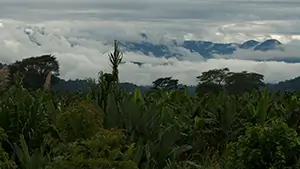 I was recently in Costa Rica. I'd planned a four-day tour of indigenous Bribri communities in the Talamanca and Yorkin Indigenous Reserves.
On the eve of my tour I walked from my guesthouse to the edge of the road. The sight I saw made me wonder two things: was I crazy?
and would my guide the next morning be a no-show? It had been raining heavily for a few days. I could barely even see the Talamanca
Mountains through the clouds. Even if my guide did show, it might only be to tell me the tour had to be cancelled. And if it wasn't cancelled,
surely the risk of traveling by motorbike, as planned, was too great.
I was recently in Costa Rica. I'd planned a four-day tour of indigenous Bribri communities in the Talamanca and Yorkin Indigenous Reserves.
On the eve of my tour I walked from my guesthouse to the edge of the road. The sight I saw made me wonder two things: was I crazy?
and would my guide the next morning be a no-show? It had been raining heavily for a few days. I could barely even see the Talamanca
Mountains through the clouds. Even if my guide did show, it might only be to tell me the tour had to be cancelled. And if it wasn't cancelled,
surely the risk of traveling by motorbike, as planned, was too great.
Early the next morning I walked through torrential rain to our arranged meeting point. He was sure who I was; no other independent backpacker
would be in this place at this time under these conditions! There was good news and bad. The tour wasn't cancelled, but most of the planned
destinations were unreachable.
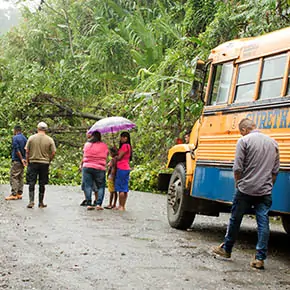 I agreed on the spot to a two-day tour instead — so long as no travel would be by motorbike.
I agreed on the spot to a two-day tour instead — so long as no travel would be by motorbike.
He confirmed that motorbike travel was out of the question and that we would reach our first destination, the tiny village of Suretka, by public transport. So we waited... and waited... and waited for the bus. Buses were arriving from multiple destinations, including Suretka, about every fifteen minutes. At first I paid no attention to that since I had no knowledge of the schedules and, in any case, bus schedules in places like this are often meaningless. But after two hours it did seem strange. Eventually our bus arrived. It was an old, donated school bus from the United States. Around thirty of us boarded and we set off. Very soon the tarmac ran out and we were now on a slick, gravel road crawling along at about 15 km/hour. After twenty minutes we stopped. It was impossible to see why since the windshield was covered in flowing rainwater. Then we reversed for a couple of kilometers until the driver had a cell phone signal. After a brief call we set off again only to come to a standstill where we already had twenty minutes earlier. And we waited... and waited... and waited. Then we were allowed off the bus and I saw the problem. A small landslide had brought down a tree and it was blocking the road.
By now I was sure my tour would be cancelled. But my guide said we should wait. Researching this trip I'd read about a road being blocked recently by a landslide in this part of Costa Rica for months beore it was cleared. Fortunately, local firefighters arrived within the hour and, an hour later, had the roadblock cleared.
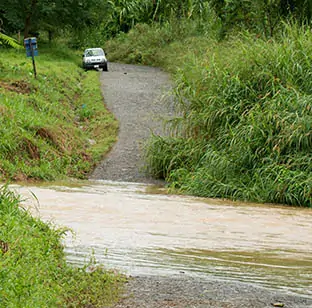
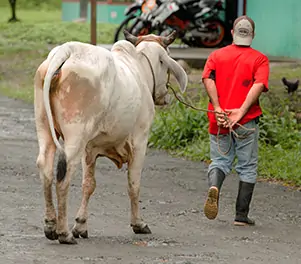 We were finally on our way to Suretka again. Or so I thought. The bus reached the outskirts of the village but, due to the risen level of what
would normally be a small stream, could go no further. We alighted and soon arranged to stay with a family for the night instead of at
the lodge where we'd initially intended to stay.
We were finally on our way to Suretka again. Or so I thought. The bus reached the outskirts of the village but, due to the risen level of what
would normally be a small stream, could go no further. We alighted and soon arranged to stay with a family for the night instead of at
the lodge where we'd initially intended to stay.
Suretka is an interesting mixture of tradition and modernity. It has had electricity for a few years now. Yet while many houses in the village are of modern construction, some are still wooden and thatched — as is the village school's main building. The visitor commonly sees glimpses of what life must have been like for thousands of years in this part of the world, such as this man herding his livestock.
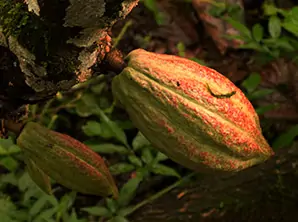 I was especially interested in one facet of Bribri culture and tradition — the role of cocoa. To us it is the main ingredient in a
chemically-treated,
I was especially interested in one facet of Bribri culture and tradition — the role of cocoa. To us it is the main ingredient in a
chemically-treated,
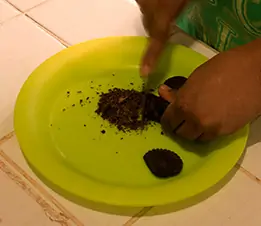 artificially sweetened instant drink to which we only have to add hot water. Or, more familiarly, it is the basis of chocolate. To indigenous
peoples throughout Central and South America it is a spiritual and ritual bean.
artificially sweetened instant drink to which we only have to add hot water. Or, more familiarly, it is the basis of chocolate. To indigenous
peoples throughout Central and South America it is a spiritual and ritual bean.
My guide first took me to a house sitting on a large plot of land. On arriving I realized this was no ordinary house. It was home to a
large family which used the land as a self-sufficient, organic and free-range farm. The lady of the farm gave me a private tour that
ended with her preparing me a cocoa drink according to traditional Bribri practice. To my palette the taste was harsh.
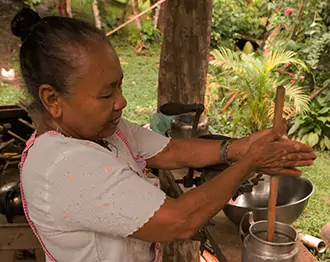
Next we visited the home of an elderly Bribri lady.
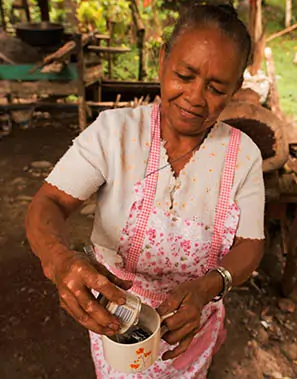 She is one of those rare souls who cross our path only a handful of times in life. She took me on a journey that ended with my understanding of cocoa. From the harvesting,
shelling, drying and roasting of the bean she demonstrated how it is then chaffed, ground and made into a paste ready to be transformed
into a drink. This time I asked her to sweeten the drink. She agreed, but told me it is best drunk unsweetened, pointing out that the need
for sweetener is a false, western view.
She is one of those rare souls who cross our path only a handful of times in life. She took me on a journey that ended with my understanding of cocoa. From the harvesting,
shelling, drying and roasting of the bean she demonstrated how it is then chaffed, ground and made into a paste ready to be transformed
into a drink. This time I asked her to sweeten the drink. She agreed, but told me it is best drunk unsweetened, pointing out that the need
for sweetener is a false, western view.
Afterward I met some of her family. We talked about daily life in the village which, for this family,
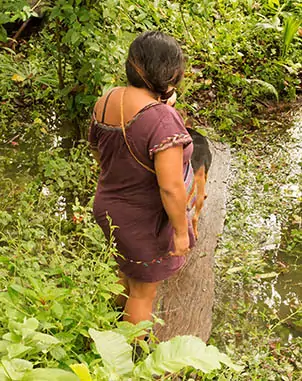 always begins with a drink of cocoa!
I thanked her for the demonstration and she said I was welcome to visit her if I was ever in the area again.
always begins with a drink of cocoa!
I thanked her for the demonstration and she said I was welcome to visit her if I was ever in the area again.
Our final visit of the day was to the house of a young shaman. While her house was modest, behind it was a forest which was also a natural pharmacy.
A full tour was not possible because of the flooding.
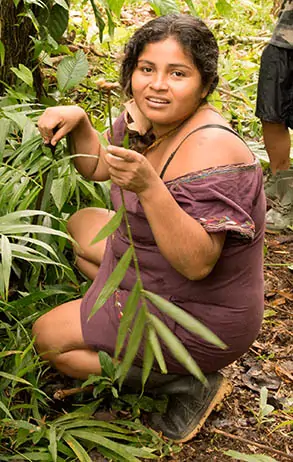 But we did spend about an hour during which she explained the kinds of ailment each plant can cure. There was a plant-based medicine prepared this way or that for just about
every symptom imaginable. I was astonished to learn there is even a plant to cure children who still wet the bed beyond a certain age!
But we did spend about an hour during which she explained the kinds of ailment each plant can cure. There was a plant-based medicine prepared this way or that for just about
every symptom imaginable. I was astonished to learn there is even a plant to cure children who still wet the bed beyond a certain age!
Since there is no reference text for this encyclopedic knowledge, I asked if she had ever thought of writing one. She told me that was her greatest wish, but, without formal education in medicine or botany, she feared no publisher would take her seriously.
She'd already shown me where in the forest she grew cocoa. So one of my questions was, naturally, did she mainly consume or sell it. She only consumed it. I was beginning to wonder whether every other person in this village might be a chocolatier! I was told that pretty much everyone drinks it, but very few villagers grow, harvest and prepare it as part of maintaining Bribri tradition. In other words, I'd already met the three chocolatiers of Suretka.
Photography and videography copyright © 1999 -
2026,
Ray Waddington. All rights reserved.
Text copyright © 1999 -
2026,
The Peoples of the World Foundation. All rights reserved.
Waddington, R., (2017) The Three Chocolatiers. The Peoples of the World Foundation. Retrieved
January 2, 2026,
from The Peoples of the World Foundation.
<https://www.peoplesoftheworld.org/travelStory.jsp?travelStory=chocolatiers>
If you enjoyed reading this travel story, please consider buying us a coffee to help us cover the cost of hosting our web site. Please click on the link or scan the QR code. Thanks!


